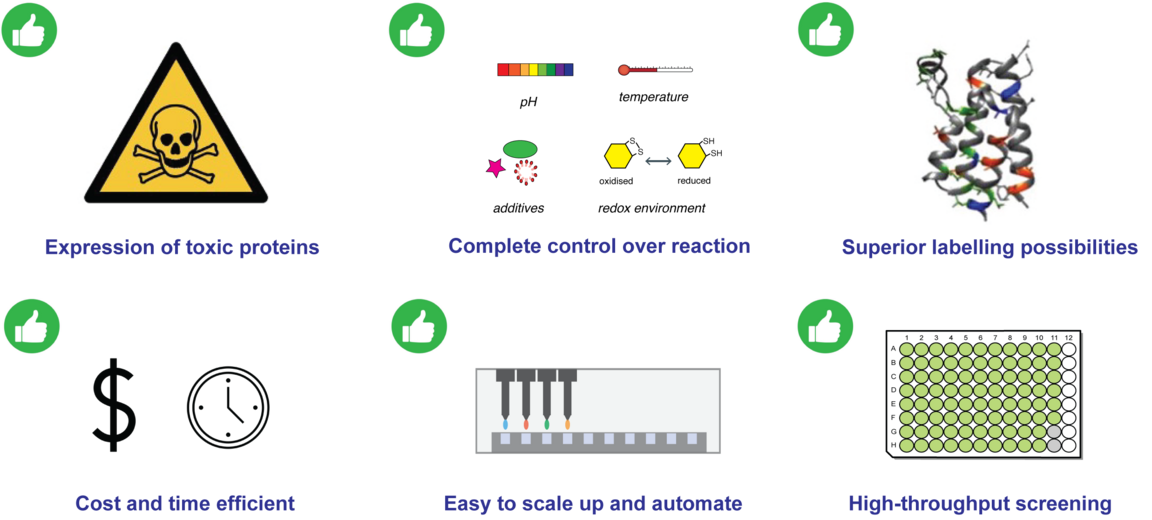Cell-Free Protein Synthesis
PPS provides specialized in vitro protein production services utilizing isolated translation machinery from E. coli, rendering it well suited for expressing a range of proteins, including those that are toxic, membrane-bound, or require diverse labelling approaches. Additionally, our platform is aiming to facilitate efficient, high-throughput protein expression screening by accommodating various protein constructs, domains, boundaries, expression conditions, and additives, all with a focus on optimizing time and cost-effectiveness.
The Cell-Free Protein Synthesis (CFPS) platform, operational at the Swedish NMR Centre (SNC) since 2007, harnesses an advanced in vitro protein expression protocol that has undergone iterative refinements [1]. As an integral component of PPS, we provide researchers with a versatile toolkit for efficient and economical recombinant protein synthesis. The CFPS workflow is illustrated in Figure 1.
In CFPS, the translation machinery is isolated from E. coli, allowing for protein synthesis from a plasmid template in a controlled in vitro environment. This approach offers numerous advantages, including the expression of cytotoxic proteins, precise redox control, and the ability to incorporate protease inhibitors, detergents, stabilizing agents, cofactors, or chaperones. Furthermore, CFPS enables superior isotope labeling options (uniform, selective, site-specific) for proteins, facilitating their use in NMR studies. The scalability of the reaction ranges from micro- to few milliliter-scale and the typical expression levels range from 50 μg to 1 mg per mL of the reaction mixture, providing valuable research reagents for structural, biophysical, biochemical characterization, as well as therapeutic purposes. The advantages of the CFPS are illustrated in Figure 2.
We have optimized a batch approach based on the use of an E. coli cell extract [2] and possess extensive experience in applying this technology to express various classes of proteins, including functional membrane proteins, soluble proteins, and intrinsically disordered proteins (IDPs) [2, 3]. These proteins can be expressed with specific labels proteins to cater to NMR users as well as users employing a wide range of structural or biophysical characterization techniques.
What PPS offers:
PPS offers the CFPS methodology for protein production as well as for testing user constructs. In general, any T7 promoter-directed construct is compatible, although vectors without lacO and/or rop are preferred for optimal results. We have adapted a CFPS-compatible vector (pCPR0012) for ligation-independent cloning. Please feel free to reach out to us with any questions about CFPS, including its operation, setup, and labelling procedures, or if you want us to test your construct. We offer CFPS in combination with subsequent protein purification and characterizations.

Figure 1.
Schematic overview of CFPS workflow and applications.

Figure 2.
Outline of the advantages of the CFPS.
[1] Pedersen A, Hellberg K, Enberg J, Karlsson BG. Rational improvement of cell-free protein synthesis. N Biotechnol 2011, 28:218-224, doi:10.1016/j.nbt.2010.06.015.
[2] Isaksson L, Pedersen A. Cell-Free Protein Synthesis of Small Intrinsically Disordered Proteins for NMR Spectroscopy. Methods Mol Biol 2020, 2141:233-245, doi:10.1007/978-1-0716-0524-0_11.
[3] Isaksson L, Enberg J, Neutze R, Karlsson BG, Pedersen A. Expression screening of membrane proteins with cell-free protein synthesis. Protein Expr Purif. 2012, Mar; 82(1):218-25, doi: 10.1016/j.pep.2012.01.003